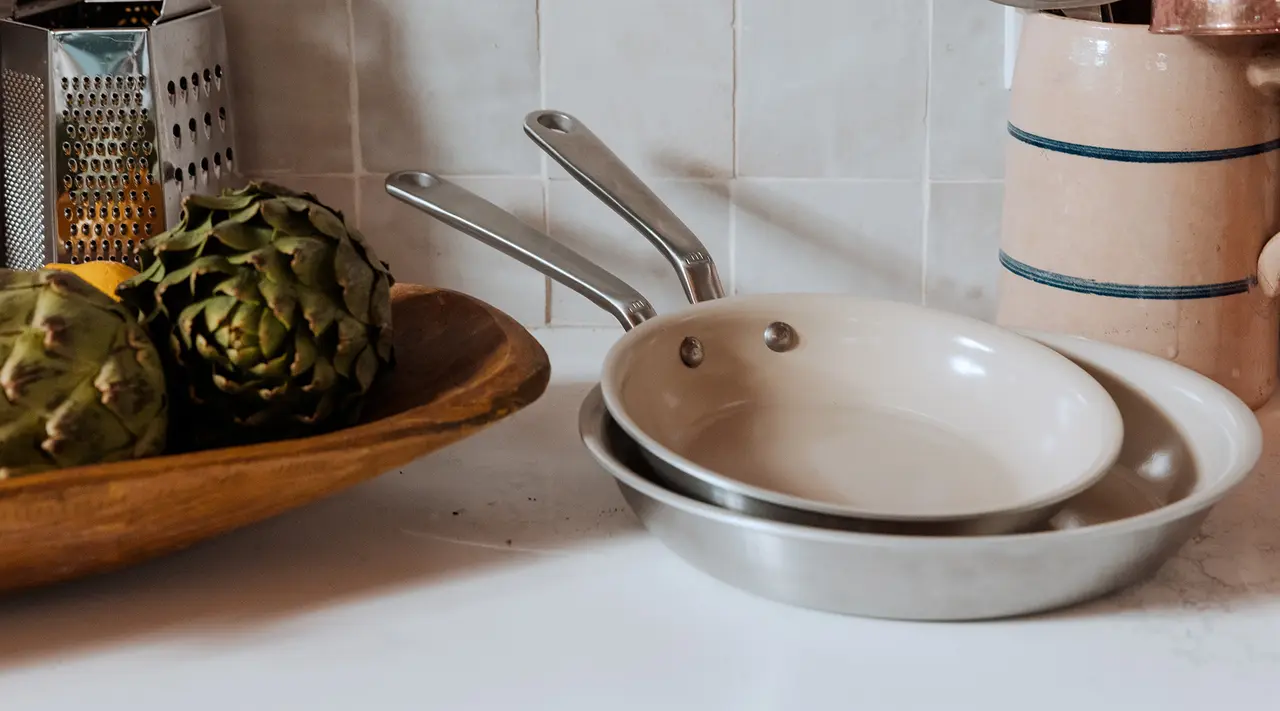While ceramic cookware is still relatively new to the market, it doesn’t take much of a learning curve to get used to cooking with it—in fact, it’s just as easy to cook with as traditional coated non stick. From proper cooking techniques to safe storage, here’s how to keep your new ceramic cookware in great working condition for as long as possible.
Understanding Ceramic Cookware

Ceramic pans, including our CeramiClad™ Non Stick Cookware, are made using a metallic base—often stainless steel, aluminum, or both—with a naturally-derived coating material that gives the pan its glossy, ceramic-like appearance. Every time you heat a ceramic pan, a tiny amount of the coating is released to create a non stick cooking surface.
This makes it a relatively eco-friendly alternative to traditional coated non stick cookware, and a good option for folks who don't want any kind of synthetic coating. It’s also similarly lightweight and just as easy to clean as conventional non stick.
Dos and Don'ts of Cooking with Ceramic Pans

You can use a ceramic pan pretty much exactly like you would any other non stick pan. With their smooth, stick-resistant surface, ceramic pans work particularly well for cooking stick-prone and/or delicate foods like eggs and fish, and they also come in handy for sautéing vegetables and tofu, simmering sauces, and making toasted sandwiches.
However, since ceramic pans—like their non stick predecessor—usually aren’t heat-safe above roughly 500F (and shouldn’t be held over high heat for more than a few minutes), they can’t be used for deep frying, searing, or similar high heat cooking methods.
Since most ceramic pans are made with a ferromagnetic aluminum or stainless steel base, you can typically use them on a gas, electric, or induction stoves. We’d advise extra caution with induction and gas, however: since both of these tend to heat quite efficiently, your pan can quickly overheat (thus causing the coating to wear out quickly) if you aren’t paying attention.
Do: Keep Heat Low
One of the main things ceramic has in common with traditional non stick is that it’s not built for high heat cooking. While the maximum temperature varies based on the manufacturer, it’s generally not a good idea to expose ceramic cookware to sustained high heat: this will wear down the coating faster, which means you’ll also need to replace it sooner.
We recommend starting our CeramiClad™ just below medium on conventional stovetops, and medium-low on higher-end ranges. We like to use our cooking fat of choice as a visual temperature gauge—if nothing happens to your cooking fat, it’s likely too low; whereas if butter is foaming and oil is shimmering, it’s ready. Just make sure it doesn’t overheat!
Do: Hand Wash Only
Cleaning and caring for ceramic cookware is honestly pretty simple—it can even be wiped out with a paper towel. That said, we do not recommend your ceramic cookware in the dishwasher. The scorching hot water, harsh detergents, and constant jostling can do some serious damage to the base and coating (even after a single wash).
Instead, take the extra time to extend the lifespan of your pan by always washing by hand, using gentle dish soap and a soft sponge or dish cloth.
Do: Store Your Pans Correctly When Not in Use
After washing and drying your ceramic cookware, make sure to store it either by stacking it—making sure to place a protective layer, like a Pan Protector or trivet, between each pan—or by hanging on a pot rack.
It’s not a great idea to leave your dirty ceramic pan (or any pan, really) stacked in the sink overnight or for several hours, as this opens up the potential for it to get stained or scratched up by other pots, pans, and utensils.
Don’t: Crank the Heat
We said it once, but it bears repeating: ceramic cookware, especially our CeramiClad™, doesn’t need to be used on high in order to thoroughly cook your ingredients. You may be used to cranking up the heat for your lower-quality non stick in order to actually cook anything, but even our culinary team was surprised by just how quickly CeramiClad™ heated up.
Little science lesson: this is because non stick coatings are insulating, so even high-quality pans need a minute to conduct heat up through the coating. Ceramic pans, like our CeramiClad™, conduct heat more like stainless steel—meaning it heats up almost immediately. We suggest medium-low to medium as the sweet spot for cooking with ceramic, and though our CeramiClad™ is oven-safe up to 550F, it should rarely (if ever) need to be used at a temperature that high.
Don’t: Use Abrasive Utensils
Much like other types of coated cookware, the coating on ceramic is quite delicate—meaning scrambling your eggs with a sharp-edged stainless spatula could permanently damage your pan. And while superficial scratches are typically nothing to worry about, anything deeper than surface level can provide the perfect breeding ground for bacteria. To avoid this, we recommend the use of soft utensils like wood, nylon, or silicone when cooking with your ceramic cookware.
Don’t: Preheat an Empty Pan
Heating an empty ceramic pot or pan is a recipe for disaster: with nothing to absorb the heat, the pan can overheat quickly, potentially warping the metallic base and degrading the coating. Always make sure to add oil or food to the pan first—even a drizzle of olive oil is better than dry heating. (But please, save the cooking spray for bakeware—it can damage the coating of your pan.)
Ready to Cook?
Ceramic cookware can be a workhorse for weeknight cooking and mess-free dinners, but that doesn’t mean you shouldn’t do your best to protect your pan. Plus, the gentler you treat your ceramic pots and pans, the better they’ll perform (and the longer they’ll last).

































